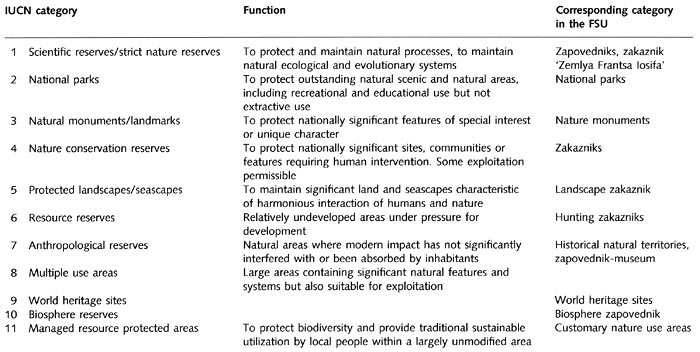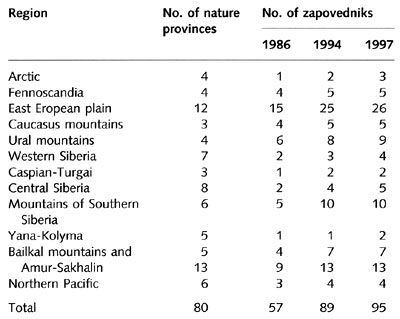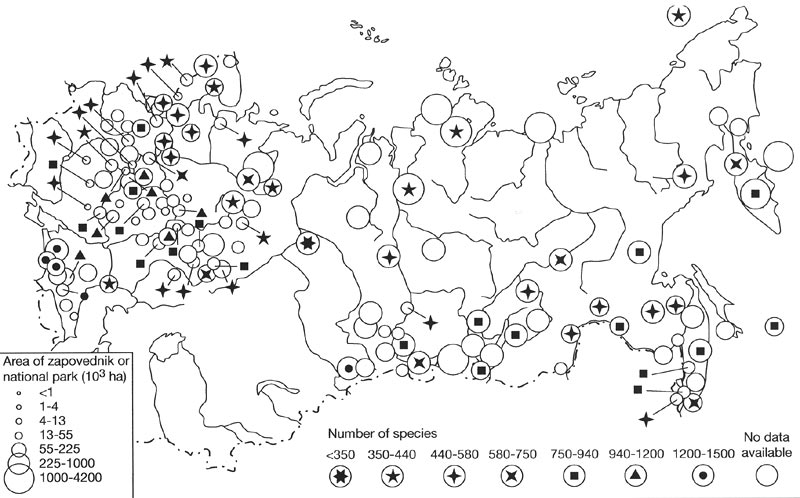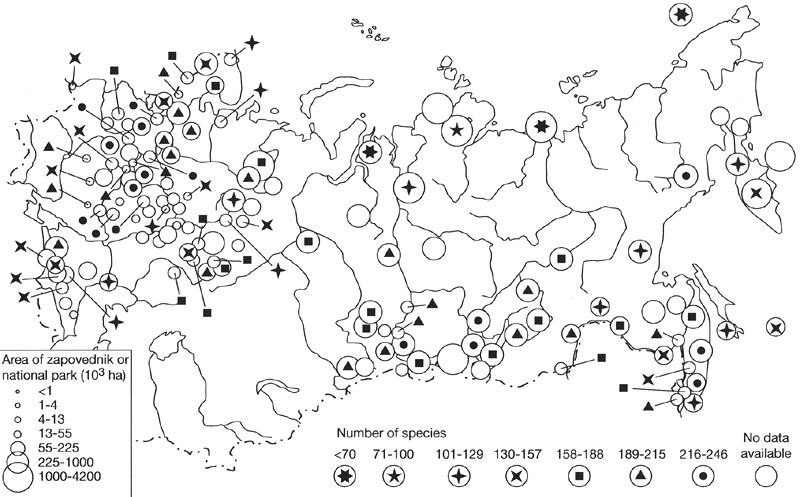Please put an active hyperlink to our site (www.rusnature.info) when you copy the materials from this page
Environmental problems of Northern Eurasia
Nature Protection and Conservation
<<< History of Conservation: Efforts
and Attitudes | Environmental Problems Index | Geography of Biodiversity and Human Impact >>>
Territorial Forms of Nature Protection
There are different categories of protected areas with a diversity of designations:
zapovednik, zakaznik, national park, nature monuments, and customary nature use areas
(Table 24.1). At the end of 1997, the Russian system of protected areas included 95
zapovedniks, 32 national parks, over 1600 state zakazniks, and about 8000 nature monuments
including 29 monuments of national importance.
See descriptions and images of Russian Zapovedniks and National parks in a special section of
our site.

Table 24.1 International Union for Conservation of Nature and Natural
Resources (IUCN) reserve categories and reserve categories used in the FSU
Zapovedniks
See descriptions and images of Russian Zapovedniks and National parks in a special section of
our site.
State zapovedniks are the strictest territorial form of nature protection (Table 24.1).
Zapovedniks are areas permanently withdrawn from economic use. They also include academic
research facilities for investigation of ecology, conservation, and monitoring of
landscape and biological diversity. Academic orientation is a distinguishing feature of
zapovedniks, which makes them superior to nature reserves in many other countries.
Traditionally, research stations owned by universities and national Academies of Science,
are attached to zapovedniks. Continuous observation of protected populations and research
on the dynamics of vegetation communities are carried out, thus creating a unique network
of research sites with 30-60 year-long data records on ecosystems and biota.
The first nature reserve, Askanya Nova, was established in the Ukraine in 1874. The
history of Russian zapovedniks dates back to 1916 when Barguzinsky zapovednik was
established near Lake Baikal to protect sable and Kedrovaya Pad zapovednik was set up in
the southern Far East to conserve the rich biodiversity of the Far Eastern forests. Since
then, the development of the zapovednik system has been following the physical
geographical and biogeographical principle that every bio-geographical region should have
a zapovednik (Tishkov, 1991, 1993, 1995; Shtilmark, 1996). Although successful, the
history of zapovedniks in the FSU is not trouble-free. For two decades, between the late
1930s and 1950s, conservation areas were considered by many Soviet officials as the
alienation of land which otherwise could be used for industrial and agricultural
development. Nature was treated as a resource that should be exploited and therefore
conservation was viewed as an obstacle to the established economic priorities. In 1951, at
a peak of the anti-preservation campaign, the number of zapovedniks was reduced by 70 per
cent and their area by 80 per cent (Pryde, 1991). Restoration of the system began in the
late 1950s, following Stalin's death and a relative democratization of the Soviet regime,
but not until the mid-1980s was the area previously occupied by nature reserves again
achieved. In most countries of the FSU, zapovedniks remain the main territorial form of
conservation, although Belarus, the Ukraine, and Baltic states now focus on the creation
of national and natural parks. The break-up of the Soviet Union, economic transformation,
decentralization of power and, in some regions, deteriorating socio-economic conditions
have put many zapovedniks (and other protected areas) under pressure. Poaching and grazing
on protected lands and attempts to use them for development have become common. However,
so far in Russia, Belarus, the Ukraine and Baltic states not a single zapovednik has been
closed. Moreover, six new zapovedniks were established in Russia between 1994 and 1997
(Table 24.2).

Table 24.2 The distribution of zapovedniks according to the
physical-geographical regions of Russia
Zapovednik territories vary widely from 2-3 km2 (Galichia Gora in Russia and
Ukrainian Steppe in the Ukraine) to 40 000 km2 in remote areas, mainly of
northern Asia (Figures 24.1 and 24.2).

Fig. 24.1 Areas of zapovedniks, national parks, and the number of
protected flora specimens

Fig. 24.2 Areas of zapovedniks, national parks, and the number of
protected fauna specimens
Depending on location and size, zapovedniks conserve between 300 and 1500 vascular
plant species which constitute between 30 per cent and 80 per cent of regional floras.
Locations and boundaries of zapovedniks are selected to combine area, representativeness,
and hot spots defined by species-richness, endemism, or distinctiveness. Recently, a
'catchment' principle has been adopted in designing zapovedniks. According to this
principle, a protected area includes the catchment of a stream, river or lake draining the
area. This creates a buffer zone and protects an ecosystem and biota designated for
protection from external impact.
At the end of 1997, there were about 300 zapovedniks in the FSU. Russia accommodates 95
of those, employing over 5000 full-time personnel, mainly academic staff, and guards. In
Russia, zapovedniks occupy a vast area of over 310 000 km2 with the terrestrial
zapovedniks accounting for approximately 262 000 km2 (State Report, 1997).
Although impressive, this system contains gaps. In Russia, zapovedniks cover only a modest
1.5 per cent of the total territory. The distribution of zapovedniks and land covered
across the FSU is uneven. For example, in northern Taymyr, zapovedniks occupy 10 per cent
of the total area, while in some steppe regions, which contain high biodiversity
threatened by overdevelopment, only 0.1 per cent of the territory is covered. Tishkov
(1995) evaluated the regional coverage with respect to zapovedniks in Russia and concluded
that many areas, especially in the biomes of polar deserts, forest-tundra, larch open
forests, steppes, and semi-deserts are under-represented (Figures 24.1 and 24.2; Table
24.2).
National Parks
See descriptions and images of Russian Zapovedniks and National parks in a special section of
our site.
National parks play an important role in the conservation of biodiversity, protection
of sites of high aesthetic or historical value, and are intended for recreation (Table
24.1 above). Because national parks have a conservation function, crucial to their
performance is a zone with a strict conservation regime. Such zones occupy between 7 per
cent and 44 per cent of the total park territory (National Parks of Russia, 1997).
Although the first suggestions to create national parks in Northern Eurasia date back
to the beginning of the 20th century, further conservation efforts focused on zapovedniks
and it was not until the 1970s that the first national parks were established in Estonia
(Lakheemaasky) and Latvia (Gauya). The first Russian national parks, Losiny Ostrov within
the Moscow urban area and Sochinsky on the Black Sea coast, were founded in 1983.
Currently, there are 32 national parks in Russia with a total area of 66 500 km2
(0.4 per cent of the country's territory). The parks vary in size from 66 km2
(Kurshskaya Kosa in the Kaliningrad region) to 19 000 km2 (Yugyd Va in the Komi
Republic).
National parks complement conservation work carried out in zapovedniks. For example,
there are no zapovedniks on the Russian coast of the Black Sea and the conservation
functions fall with the Sochinsky national park which preserves habitats of European
tortoise and also more than thirty plant species listed in the Red Data Book (1988). The
Valday national park protects the only large forest massif between the two largest Russian
cities, Moscow and St. Petersburg, which harbours large game, mainly brown bears.
Zakazniks
Zakazniks are areas withdrawn for either permanent or temporary protection. This form
of nature protection usually corresponds to category 4 of the IUCN classification (Table
24.1), although some zakazniks do not meet the category 4 criteria and should be
attributed to categories 6 or 7. On the other hand, the largest zakaznik, Zemlia Frantsa
losifa which was founded in 1994 on Franz Josef Land and occupies 42 000 km2,
is regarded as a category 1 protected area. Zakazniks are aimed at protecting one or many
components of the natural environment. Their status can be national, republican, regional
or local. The key function of zakazniks is animal and game conservation, and breeding and
often they integrate conservation with hunting. Zakazniks also protect rare species
including 21 mammal and 68 bird species listed in the Red Data Book (1988).
At the end of 1997, there were more than 1600 zakazniks in Russia with a total area of
more than 600 000 km2 (State Report, 1997). Among those, 66 are of national
importance. Another 19 zakazniks conserve wetlands of international significance under the
1971 Ramsar Convention.
Nature Monuments
Nature monuments are relatively small territories or individual nature objects which
are conserved without land withdrawal by the decision of local authorities. Unique
geological outcrops, habitats of rare plants or animals, a wood, a lake or an ancient tree
can be given the status of a nature monument. This form of protection was initiated in the
1960s and proved an efficient and flexible way to realize local initiatives for
small-scale conservation. It is especially popular in the regions where non-governmental
organizations are actively involved in conservation. For example, in the Komi Republic
there are about 500 nature monuments. However, in those regions where environmental
awareness of the public and local authorities is not strong, nature monuments come under
particular pressure. At the end of 1997, there were about 8000 nature monuments in Russia.
Of these 29 are of national importance and mainly protect small woodlands.
Customary Nature Use Areas
Customary nature use areas are a comparatively new form of nature protection in the
regions of residence of indigenous communities in the Russian north, Siberia, and the Far
East. They are created by the decision of local authorities and have been established in
the Khabarovsk region, on the Yamal and Taymyr peninsulas. The development of these areas
is limited so that indigenous peoples can maintain their traditional occupations such as
hunting, fishing, and trapping. This form of nature protection does not create the
conflict that often exists between conservation (i.e., ban on hunting and fishing in
nature reserves) and traditional economies.
<<< History of Conservation: Efforts
and Attitudes | Environmental Problems Index | Geography of Biodiversity and Human Impact >>>
Contents of the Nature Protection and
Conservation section:
Other sections of Environmental Problems of Nortern Eurasia:
|
|